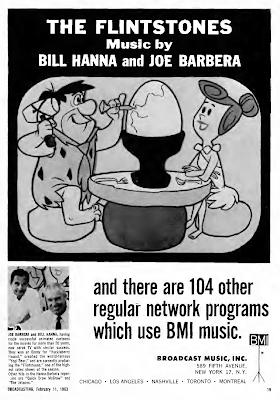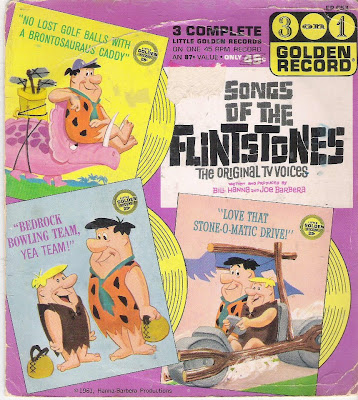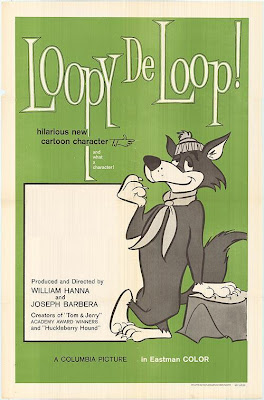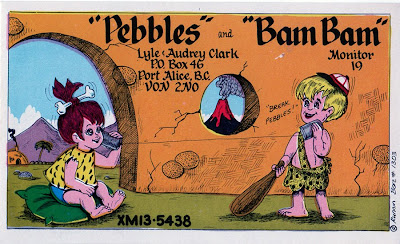 Produced and Directed by Bill Hanna and Joe Barbera.
Produced and Directed by Bill Hanna and Joe Barbera.Animation – Don Patterson, Layout - Dick Bickenbach, Backgrounds – Dick Thomas?, Story – Mike Maltese, Story Director – Alex Lovy, Titles – Art Goble, Production Supevision – Howard Hanson (no credits).
Voice Cast: Quick Draw, Baba Looey, Bank Teller – Daws Butler; Narrator, Townsman, Fast-Gun Finnegan, Little Man – Doug Young.
Music: Phil Green, Jack Shaindlin, Harry Bluestone/Emil Cadkin.
Episode: Quick Draw McGraw Show M-028, Production J-84.
First Aired: 1960.
Plot: Quick Draw tries to bring in a bad guy while dealing with a mechanical sheriff.
 “Fight fire with fire, and tin with tin, I always say!” declares Quick Draw McGraw. And so, dressed in armour made from an old hot water heater (with pipes sticking out of his hat), our hero walks into battle, hand ready to reach for his gun—and take on the good guy.
“Fight fire with fire, and tin with tin, I always say!” declares Quick Draw McGraw. And so, dressed in armour made from an old hot water heater (with pipes sticking out of his hat), our hero walks into battle, hand ready to reach for his gun—and take on the good guy. Good guy?!? Yes, it’s another inspired story from Mike Maltese, who came up with the concept of a mechanical sheriff years before Mel Brooks in Blazing Saddles—one that has a brain buried in that tin, as we discover. Quick Draw spends the cartoon trying to prove to a town that they need him as sheriff, even though it clearly doesn’t, and he wins in the end—but only temporarily.
Some of the poses are pretty nice. They’re by Don Patterson. I especially like how Quick Draw’s snout becomes pancaked by Clarence’s fist.

Here’s Baba’s mouth in an “o” shape as he yells “Yahoo!” The lips are stretched out forward, like something out of an early ‘30s cartoon from New York.

And here’s one of Patterson’s drawings of Quick Draw zipping out of the scene. The animation’s used twice in the cartoon.

The lack of credits is annoying. Who did the backgrounds? The clouds are like Art Lozzi’s but the two-tone mountains and mesas are the same as Dick Thomas drew in the Snooper and Blabber cartoon “Outer Space Case” (which does have credits). So, I’m going with Thomas. Note there’s a sign in this cartoon drawn like the one in “Bad Guys Disguise” in the first season.
Dick Bickenbach was the layout artist on that one, and he draws the townsman’s ear like he did Tombstone Jones in the earlier cartoon; it’s shaped like a fortune cookie. You’ll notice Baba’s eyes are closed like a baseless triangle dissected down the middle, typical of Patterson at Hanna-Barbera at the time.

And here’s part of Lozzi’s town we see at the beginning. It’s one with pale rose-shadowed mountains in the background.

 The cartoon opens with a pan over the background above, with Doug Young’s narration explaining that Fast-Gun Finnegan was tougher than Billy the Kid and the James boys, and “could not be brought to justice.” The narrator is interrupted by Quick Draw McGraw, who promises to do it. Baba Looey then adds that “any minutes now, Fast-Gun Finnegan will come a-runnin’ to give hisself up.” How? “You tell ‘im, Baba boy. I’m too modest. And don’t leave nothin’ out.” The cartoon now flash-backs to the morning when Quick Draw and Baba arrive in Peaceful Gulch, a town with no sheriff, and doesn’t need one, as Quick Draw is told when he applies for the job. Quick Draw decides to prove the town needs a sheriff by staging a fake bank hold-up so he can arrest the bandit. Baba to the audience: “I’ll give you one guess who’s going to be the bandit.”
The cartoon opens with a pan over the background above, with Doug Young’s narration explaining that Fast-Gun Finnegan was tougher than Billy the Kid and the James boys, and “could not be brought to justice.” The narrator is interrupted by Quick Draw McGraw, who promises to do it. Baba Looey then adds that “any minutes now, Fast-Gun Finnegan will come a-runnin’ to give hisself up.” How? “You tell ‘im, Baba boy. I’m too modest. And don’t leave nothin’ out.” The cartoon now flash-backs to the morning when Quick Draw and Baba arrive in Peaceful Gulch, a town with no sheriff, and doesn’t need one, as Quick Draw is told when he applies for the job. Quick Draw decides to prove the town needs a sheriff by staging a fake bank hold-up so he can arrest the bandit. Baba to the audience: “I’ll give you one guess who’s going to be the bandit.”  “Now, remember,” Quick Draw says to Baba to start the next scene. “Shoot twice-t over your shoulder and yell ‘Yahoo’,” —the “sig-giginal” (Daws Butler’s word-bending at work again) for Quick Draw to make the phoney arrest. Baba gets nowhere. The bank teller pushes a button to activate Clarence, the mechanical sheriff. Baba gives the signal, but also fires his gun which brings down the bank sign on top of Quick Draw’s head, which gives him temporary amnesia (“Who am I? What am I? Besides bein’ good lookin’,”) and thus has no idea what the signal is. Clarence throws Baba on top of Quick Draw’s head to restore his memory.
“Now, remember,” Quick Draw says to Baba to start the next scene. “Shoot twice-t over your shoulder and yell ‘Yahoo’,” —the “sig-giginal” (Daws Butler’s word-bending at work again) for Quick Draw to make the phoney arrest. Baba gets nowhere. The bank teller pushes a button to activate Clarence, the mechanical sheriff. Baba gives the signal, but also fires his gun which brings down the bank sign on top of Quick Draw’s head, which gives him temporary amnesia (“Who am I? What am I? Besides bein’ good lookin’,”) and thus has no idea what the signal is. Clarence throws Baba on top of Quick Draw’s head to restore his memory. 



 Baba explains to Quick Draw the town has Clarence so they don’t need him as sheriff. “Hold on thar! Anybody named Clarence couldn’t be such a much.” Quick Draw goes to the entrance of the bank and ends up getting socked by the mechanical man, after thinking a teeny man coming out of the bank is Clarence and challenges him to a punch. The scene’s a little puzzling. The little man says “I couldn’t hit anybody,” says the meek man. My hands have small bones.” Quick Draw replies with “Now, don’t hurt your small-boned hand,” even though he can see the mechanical man in front of him; in fact, Clarence brushed off his nose. So I don’t understand why Quick Draw still mistakes one for the other. Catchphrase after the punch: “Ooo. That smarts!”
Baba explains to Quick Draw the town has Clarence so they don’t need him as sheriff. “Hold on thar! Anybody named Clarence couldn’t be such a much.” Quick Draw goes to the entrance of the bank and ends up getting socked by the mechanical man, after thinking a teeny man coming out of the bank is Clarence and challenges him to a punch. The scene’s a little puzzling. The little man says “I couldn’t hit anybody,” says the meek man. My hands have small bones.” Quick Draw replies with “Now, don’t hurt your small-boned hand,” even though he can see the mechanical man in front of him; in fact, Clarence brushed off his nose. So I don’t understand why Quick Draw still mistakes one for the other. Catchphrase after the punch: “Ooo. That smarts!” Catchphrase to start the next scene: “I’ll do the thinnin’ for both of us...” This is when Quick Draw dresses up in the stove outfit and shoots at Clarence. I love how Quick Draw is so satisfied with himself when he’s ravingly incompetent. The bullets just bounce off Clarence’s metal, but Quick Draw says “That’s pretty good shootin’, eh, Clarence?” The metal sheriff simply bends at 90 degrees, turns himself into a cannon and fires. We hear a bell sound effect when the cannon ball hits Quick Draw.


Oh, yes, Fast-Gun Finnegan. Now he shows up in the story to rob the bank. Quick Draw warns him about Clarence. “Anybody named Clarence couldn’t be such a much,” laughs Finnegan. The cartoon now returns to the present with Baba talking to the narrator. Just then, a clothing-torn Finnegan runs screaming to be locked up. Clarence isn’t around so the audience is left to assume what happened (saves animation, too).
 What’s Quick Draw going to do with the reward for the capture? Take apart Clarence bolt-by-bolt so he can be sheriff. Clarence may be mechanical, but he understands the situation and fires more cannon balls at Quick Draw. The cartoon ends with our hero running from a bunch of cannon balls toward “Arizony.” Baba’s tagline: “That’s what I like about Quickstraw. Once he finishes a job, he’s off to a new place. Whether he likes it or not.” Yeah, it’s not strong, or even a pun. But Maltese seems to have made a decision a quip from Baba should end all cartoons (it does in all 13 of them in the second season) so that’s what he came up with.
What’s Quick Draw going to do with the reward for the capture? Take apart Clarence bolt-by-bolt so he can be sheriff. Clarence may be mechanical, but he understands the situation and fires more cannon balls at Quick Draw. The cartoon ends with our hero running from a bunch of cannon balls toward “Arizony.” Baba’s tagline: “That’s what I like about Quickstraw. Once he finishes a job, he’s off to a new place. Whether he likes it or not.” Yeah, it’s not strong, or even a pun. But Maltese seems to have made a decision a quip from Baba should end all cartoons (it does in all 13 of them in the second season) so that’s what he came up with. The sound cutter gives Clarence his own little theme. It’s Jack Shaindlin’s “Six Day Bicycle Race.” Phil Green dominates the rest of the soundtrack and we get a harmonica version of “Red River Valley” which may be from the Sam Fox library.
0:00 - Quick Draw McGraw Sub Main Title theme (Curtin).
0:15 - Red River Valley (Trad) – Pan of town, poster, “Hold on thar!”
0:30 - GR-99 THE DIDDLECOMB HUNT (Green) – Quick Draw talks to narrator, sign scene.
1:17 - GR-255 PUPPETRY COMEDY (Green) – Quick Draw talks to townsman, teller presses button.
2:23 - SIX-DAY BICYCLE RACE (Shaindlin) – Clarence rolls out, Quick Draw loses memory, regains memory.
3:04 - GR-87 SKELETON IN THE CUPBOARD (Green) – “Hold on thar!” Quick Draw talks to little man, teller presses button.
4:06 - SIX DAY BICYCLE RACE (Shaindlin) – Clarence rolls out, clobbers Quick Draw.
4:24 - GR-87 SKELETON IN THE CUPBOARD (Green)) – Quick Draw’s nose is pancake, Quick Draw as stovepipe.
5:04 - SIX DAY BICYCLE RACE (Shaindlin) – Clarence rolls out, cannon fire, Quick Draw talks to Finnegan.
6:04 - CB-87A COME AND GET ME (Cadkin-Bluestone) – Baba talks to narrator, Finnegan yells for help, Quick Draw with gun on Finnegan.
6:31 - SIX DAY BICYCLE RACE (Shaindlin) – Clarence rolls out, Quick Draw runs to Arizona, Baba talks to camera.
7:00 - Quick Draw McGraw Sub End Title theme (Curtin).

















































































































































